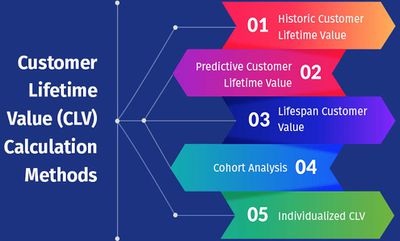Customer Lifetime Value (CLV)
Marketing metrics
Customer Lifetime Value (CLV) is a crucial metric that helps businesses assess their customers’ long-term value and profitability. It addresses the estimated total income a customer should generate throughout their relationship with a company. CLV is a valuable tool for strategic decision-making, as it allows businesses to allocate assets beneficially, encourage compelling marketing strategies, and prioritize customer retention endeavours. Several factors are considered to calculate CLV, including average purchase value, purchase repeat, customer lifespan, and acquisition costs. By analyzing these metrics, businesses can estimate the future income potential of individual customers and make informed decisions regarding customer acquisition, retention, and relationship management. CLV gives various benefits to businesses. Most importantly, it helps perceive high-value customers who contribute significantly to the company’s income. By focusing on these customers, businesses can tailor their marketing endeavours and give personalized experiences to enhance customer satisfaction and loyalty. Secondly, CLV assists in determining the appropriate marketing spending plan allocation. By understanding the potential income generated by various customer fragments, businesses can allocate assets, enhance their marketing investments and maximize returns. Additionally, CLV helps businesses evaluate the viability of their customer acquisition strategies and customer retention programs.
It enables them to assess whether the expense of acquiring and retaining customers is legitimate to the long-term value they bring to the company. Furthermore, CLV helps businesses make strategic decisions regarding pricing strategies, item improvement, and customer segmentation. By understanding the profitability of various customer portions, businesses can align their pricing strategies to maximize income and profitability. CLV also gives insights into customer inclinations and behaviours, enabling businesses to foster items and administrations that address their customers’ issues and inclinations, ultimately driving customer satisfaction and loyalty.
However, it is essential to note that CLV calculations depend on assumptions and estimations, which may introduce some level of uncertainty. Variables, for example, customer beat rates, discount rates, and future purchase behaviours, can impact the accuracy of CLV calculations. Businesses ought to continuously monitor and update their CLV models to guarantee they mirror the changing dynamics of their customer base and market conditions.
In conclusion, Customer Lifetime Value (CLV) is a potent indicator that enables companies to assess their customers’ long-term worth and profitability. Businesses can prioritize customer retention, enhance their marketing initiatives, and make data-driven decisions by calculating CLV. CLV provides information on customer behaviour, aids resource allocation, and directs strategic decision-making, ultimately improving customer pleasure, loyalty, and corporate performance.




